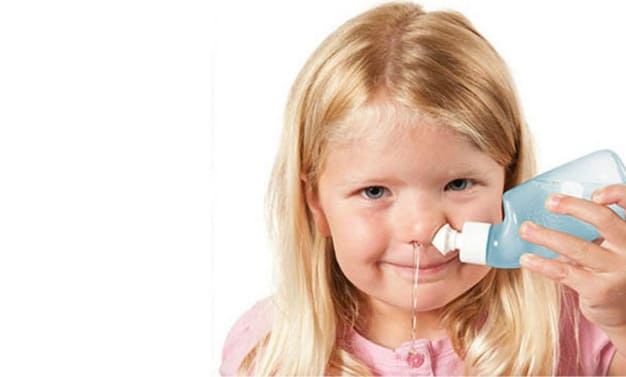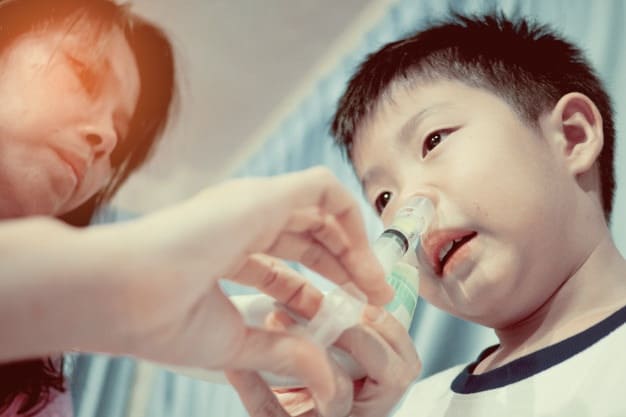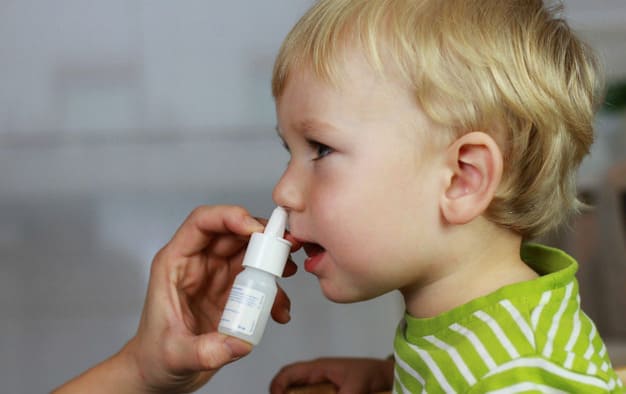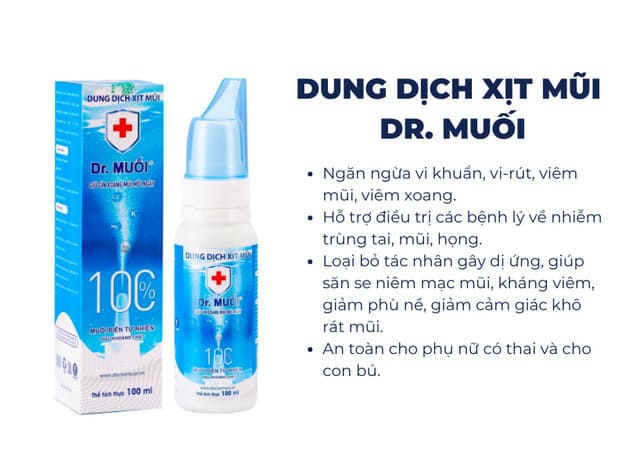How to wash children’s nose and mistakes that mothers often make
When having respiratory problems, children easily get stuffy nose and runny nose which is very uncomfortable. To effectively treat this condition, mothers need to perform nasal irrigation for their babies. However, how to wash the baby’s nose is the right thing that mothers often wonder about. Therefore, let’s learn the right steps to wash the nose for children, helping them quickly clear their stuffy nose and stuffy nose.

1. Why should you wash your child’s nose properly?
Nasal irrigation for children helps clear the mucus inside the nasal cavity, preventing rhinitis or other uncomfortable symptoms of nasal congestion. Normally, a baby’s nose has secretions to moisten and warm the air that passes through. But the secretions are usually small and gradually excreted down the throat.
When the baby has nasal diseases, this mucus secretion is thicker and more dense, making the nose unable to excrete itself. Therefore, when rinsing the nose, this cloudy mucus easily flows out with the water. That means the thick fluid is no longer in the baby’s nasal cavity. Because the water has liquefied them and pulled them out more easily.

In fact, how to wash a child’s nose is not too difficult, it can be done at home. You just need to use salt water and a bottle to pump into the nose. With young children, you should let your baby get used to the same tool first, like letting him play in the bath, for example. In addition, you can also let your baby watch clips on Youtube so that he can see that his peers can do it too.
Finally, the correct nasal irrigation of children contributes to reducing antibiotic use. Proper nasal irrigation washes away all secretions and makes the baby’s nose easier to breathe, more open. In addition, some allergens can also be caught up, your baby does not need additional allergy relievers or decongestants.
2. Common mistakes when washing children’s nose
2.1 Improper use of nasal irrigation syringe
There are many mothers who use syringes to wash their children’s nose. But up to 99% of mothers do not know that the way to pump the child’s nose with a saline syringe directly into the nose will be very dangerous for the baby. Because the cylinder has high pressure and is not precise. If the pump is not careful, strong manipulation will cause damage to the baby’s nasal mucosa, leading to edema, causing prolonged nasal congestion and inflammation of the middle ear.
 Using a nasal irrigation syringe has many harmful effects on the baby
Using a nasal irrigation syringe has many harmful effects on the baby
In addition, there are many types of cylinders with sharp tips, which are easy to scratch the mucous membranes or more seriously, bleed the baby’s nose. There have been many cases of mothers using the wrong syringe, causing the nasal rinse to flow back into the respiratory system, causing the baby to choke on saline into the lungs. Therefore, this is not the right way to wash the baby’s nose that mothers should do.
2.2 Let the baby lie down while rinsing the nose
Leaving the baby lying down while washing the nose is a very common mistake. Not to mention, some mothers put too much pressure when their baby cries and screams while washing their nose, which also makes the baby afraid and averse to washing the nose. Everyone knows that parents want their children to recover quickly, so they often try to manipulate them. However, letting the baby lie down and forcing the baby to wash the nose can easily cause the child to choke back into the lungs, making the disease worse.
In addition, some mothers also force their babies to lie on their side and then forcefully spray saline water into their noses. This way of washing the baby’s nose is wrong because it makes the baby easy to choke. When the baby chokes, the baby will swallow or cough, causing water to overflow into the ears immediately. That is the reason why many children with rhinitis have not recovered, but also have otitis media due to the accumulation of pus in the ear.
2.3 Do not clear the mucus when rinsing the baby’s nose
If you just proceed to wash the baby’s nose without aspirating the nasal secretions or just use a tissue and suck it outside, then cleaning the nose really doesn’t work. Because if you only wash your nose and don’t suck it outside for a long time, the mucus inside will stagnate, making your baby’s runny nose worse.

3. Basic steps to wash your baby’s nose
Before washing the baby’s nose, the mother washes her hands thoroughly with soap and water for 30 seconds. In addition, you can also use alcohol hand sanitizer for quick.
Proceed to withdraw saline into a medical syringe (with the tip of the needle removed) or a dedicated nasal irrigation device
Have your baby stand in front of the sink or in a position to flush. Then, you insert the syringe tip or nasal wash bottle into the baby’s nostril, gently inject saline. Never close the other nostril.
The baby should tilt his head to one side and vice versa when pumping saline to wash his nose
Parents, note that the direction of the water pump is directed to the back of the baby’s head, not towards the top of the baby’s head
When done correctly, saline will go from the nostril on the pump side and flow in the other nostril
After properly rinsing your child’s nose, let him blow his nose gently to clear the mucus
Finally, clean the syringe or wash it, leave it in a cool, dry place
Note, if your doctor prescribes a nasal spray for your baby, you should wash your nose before using it. Cleaning the nose will help the nose and nasal sinuses absorb the medicine better.
Instructions for proper nose washing of Vinmec hospital
4. Nasal spray Dr. Salt – effectively cleans the nose
In addition to applying nasal irrigation for young children under the guidance of experts, you can use specialized nasal cleaning products such as Dr. Salt. The product is made from natural sea salt, rich in trace minerals and essential oils of eucalyptus, mint, etc. to help clean the nasal cavity, creating a feeling of ventilation and comfort.
 Dr. Salt nasal spray solution helps to clean the nose and prevent infection effectively
Dr. Salt nasal spray solution helps to clean the nose and prevent infection effectively
The product also prevents bacteria, viruses, sinusitis and supports the treatment of ear, nose and throat infections. For children, using a spray 1-2 times a day can help eliminate allergens, anti-inflammatory, astringent nasal mucosa and reduce nasal dryness. The selling price is only 30,000 VND / 100ml bottle – this is a safe, effective and economical solution to take care of your baby’s nose and throat health and the whole family.
You Can Refer To More Articles:
Should I wash my nose with physiological saline?
Instructions for Self-healing Sinusitis with Physiological Salt Water
Tips for Treating Allergic Rhinitis with Physiological Salt Water Simple and Effective
Instructions on how to hydrate with salt water to treat bad breath
